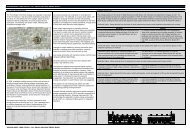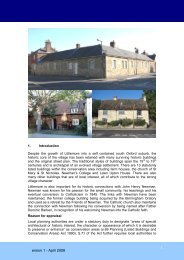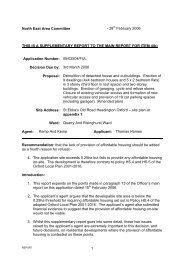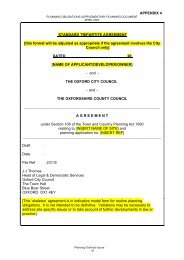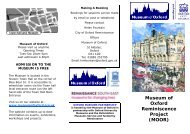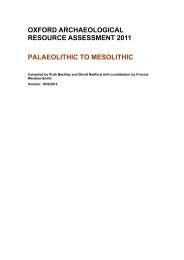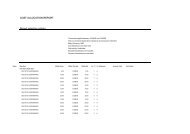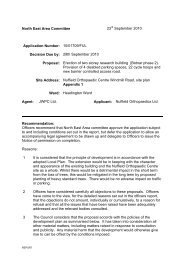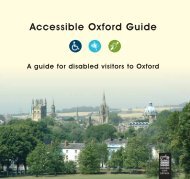Post-medieval Oxford - Oxford City Council
Post-medieval Oxford - Oxford City Council
Post-medieval Oxford - Oxford City Council
You also want an ePaper? Increase the reach of your titles
YUMPU automatically turns print PDFs into web optimized ePapers that Google loves.
The University of <strong>Oxford</strong><br />
<strong>Oxford</strong> university and its colleges have been extensively studied in terms of their<br />
buildings and history (RCHM 1939; Stone 1975; Green 1984; Prest ed. 1993; VCH iii;<br />
Catto et al. 1984-2000; Sherwood and Pevsner 1974; Tyack 1998). The buildings of<br />
the university have been described and illustrated over a long period (Loggan 1675;<br />
Williams 1732; Durning 2006). A further study of buildings designed but never built<br />
has been produced by Colvin (1983).<br />
Built structures and garden design<br />
<strong>Post</strong>-<strong>medieval</strong> colleges did not alter from the <strong>medieval</strong> pattern laid down in the 14th<br />
century and colleges were largely built in the standard quadrangle form with internal<br />
gardens. Cartographic evidence from the 16th century onwards indicates the<br />
prevalence of formal garden design, however, later maps show some changes to<br />
almost all college gardens (Mowl 2007: 136).<br />
The university<br />
Bodleian Library and the Schools Quadrangle<br />
The Bodleian Library and the Schools Quadrangle stand to the south of the<br />
Sheldonian theatre and the Old Clarendon Building. The walls are of local rubble,<br />
ashlar-faced, and the roofs are lead-covered. Duke Humfrey's Library was built over<br />
the new Divinity School in 1427-89. By the mid-16th century, it was in a decayed<br />
state and was restored in 1598-1602 by Thomas Bodley. The Bodleian Library<br />
opened in 1602. The Arts End extension was built in 1610-12 and Schools<br />
Quadrangle was completed in 1624, not as a library, but primarily as a series of<br />
teaching rooms with the University Gallery on the top floor. A further extension was<br />
made in 1637 when Selden End was added. The construction of the Schools<br />
Quadrangle in the 17 th century involved the whole-scale demolition of the <strong>medieval</strong><br />
schools on Schools Street (see Medieval Resource Assessment for more details).<br />
Excavations in the Bodleian Quadrangle for a static water tank in 1941 recorded<br />
pottery dated from the Late Saxon period to the early 17th century (anon 1943-4).<br />
Further excavations at the Bodleian Library, Proscholium in 1968, noted porch<br />
foundations extending c.0.5 metres from the front wall of the Divinity School (anon<br />
1972). A detailed survey of the Duke Humfrey’s Library roof was undertaken in 1998,<br />
when dendro-chronology of the roof timbers revealed the sequence of building and<br />
the extent of Bodley’s rebuilding (UAD 518).<br />
A gateway stood at the east end of Brasenose Lane, facing down the former Schools<br />
Street. It was built in 1558 when the university closed off the northern part of the<br />
street. The gate was incorporated into the Bodleian Library at its south entrance<br />
around 1624 (Munby 1972), but in the early 18th century it was demolished when<br />
that land passed to Exeter College for its enlarged garden.<br />
Divinity School Convocation House<br />
The 15th century Divinity School already sat beside the <strong>medieval</strong> schools in School<br />
Street. On the east side of the road, the Oseney Schools were rebuilt by Queen<br />
Mary’s benefaction, only to be removed for Bodley’s Arts End and Proscholium. The<br />
later 17th century saw the addition of the Convocation House to the west and the<br />
Schools Quadrangle to the east, the whole now being part of the Bodleian Library<br />
complex (LB Ref 9/147a). The opening up of this area of the city subsequently<br />
allowed for the addition of several new buildings.<br />
OXFORD ARCHAEOLOGICAL RESOURCE ASSESSMENT- POST MEDIEVAL<br />
42



